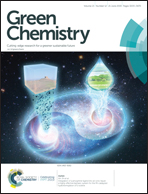Integration of a phosphine ligand into an ionic liquid: a highly effective biphasic system for the Rh-catalyzed hydroformylation of 1-octene†
Abstract
In classical biphasic ionic liquid (IL) catalysis, the use of a large amount of solvent IL is a major limitation, and usually leads to a waste of resources and relatively low reaction efficiency. So far, it has remained a challenge to establish a highly effective and long-life IL catalytic system that can utilize IL in a relatively efficient, green, and economical manner. Herein, a class of room-temperature phosphine-functionalized polyether guanidinium ionic liquids (RTP-PolyGILs) were synthesized using a simple ion exchange reaction of TPPTS with polyether guanidinium ionic liquids (PolyGILs) based on the notion of integrating phosphine ligand into the IL. These RTP-PolyGILs displayed the characteristics of the phosphine ligand and the solvent IL in both structure and properties, and could thus act not only as ligands to bind metal catalysts but also as catalyst carriers. By exploiting the dual functions of RTP-PolyGILs, we constructed a highly effective, green, and economical biphasic system for the Rh-catalyzed hydroformylation of 1-octene, and examined how the structures of the RTP-PolyGILs affected the activity, selectivity, and stability of the Rh catalysts. It was found that only a catalytic amount of RTP-PolyGILs (about 0.1–0.4 mol% 1-alkenes) was needed to give a high TOF of up to 2300 h−1, good aldehyde selectivity, long service life with a total turnover number (TTON) of up to 47 000, and low Rh leaching of only 0.07–0.3 ppm.



 Please wait while we load your content...
Please wait while we load your content...